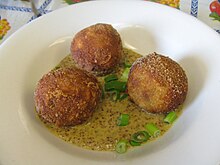
Boudin (French pronunciation: [budɛ̃]) are various kinds of sausage in French, Luxembourgish, Belgian, Swiss, Québec, Acadian, Aostan, Louisiana Creole, and Cajun cuisine.

Boudin (French pronunciation: [budɛ̃]) are various kinds of sausage in French, Luxembourgish, Belgian, Swiss, Québec, Acadian, Aostan, Louisiana Creole, and Cajun cuisine.
The Anglo-Norman word boudin meant 'sausage', 'blood sausage', or 'entrails' in general. Its origin is unclear. It has been traced both to Romance and to Germanic roots, but there is not good evidence for either (cf. boudin).[1] The English word pudding probably comes from boudin.[2]
Some modern chefs, such as John Folse[3] and Olivier Poels, attribute boudin to ancient Greece by way of Aphtonite,[4][5] to whom they attribute the first mention of boudin noir in the Apicius.[6][7]

The journals of the Lewis and Clark Expedition include an early record of boudin blanc in the Louisiana Territory during an encounter with French fur trapper Toussaint Charbonneau on May 9, 1805, who prepared it using buffalo intestine, meat, and kidney suet, boiled the links, and fried them in bear grease.[21]
The term boudin in the Acadiana region of Louisiana is commonly understood to refer only to boudin blanc, and specifically to the regional combination of rice, pork, and seasonings originally made at rural communal hog butcherings since the 18th century.[22] Also popular is seafood boudin, consisting of crawfish or crab, shrimp, and rice.[12]
Cajun boudin is available most readily in the Acadiana region of southern Louisiana, though it may be found nearly anywhere in "Cajun Country" extending along the coast of the Gulf of Mexico from eastern Texas[12] to western Mississippi.[23] Several Louisiana towns and cities stake claims based on their boudin; Scott, Louisiana, was named "Boudin Capital of the World" in 2012, while Jennings was named "Boudin Capital of the Universe"[24] and former "Boudin Capital of the World" Broussard redesignated itself the "Intergalactic Boudin Capital of Positive Infinity".[25]
There are numerous meat markets and Cajun stores devoted to the speciality, though boudin is also sold from many convenience and grocery stores in other towns and areas along Louisiana's portion of Interstate 10, referred to by the Southern Foodways Alliance and some local tourism bureaus as the Southern Boudin Trail.[26][27][28] Since Cajun boudin freezes well, it can be shipped outside the region if made and packaged in a federally approved facility.[29]
Boudin noir is available in Illinois in the Iroquois County towns of Papineau and Beaverville, with their Quebecois heritage. The dish is the featured cuisine at the annual Beaverville Founder's Day, held the second weekend of September. People travel from hundreds of miles to partake of the boudin.[30]
Boudin gave rise to "Le Boudin", the official march of the French Foreign Legion. "Blood sausage" is a colloquial reference to the gear (rolled up in a red blanket) that used to top the backpacks of Legionnaires.[31] The song makes repeated reference to the fact that the Belgians do not get any "blood sausage", since the king of the Belgians at one time forbade his subjects from joining the Legion (the verse says "ce sont des tireurs au cul").[citation needed]